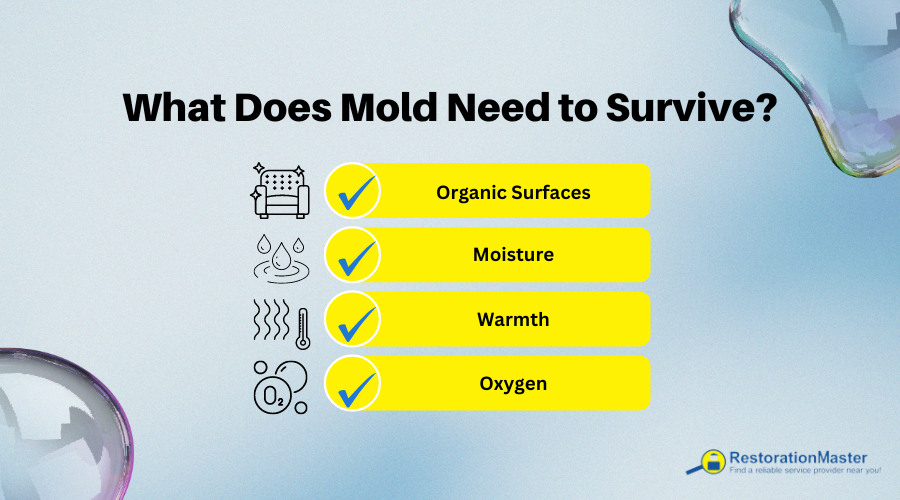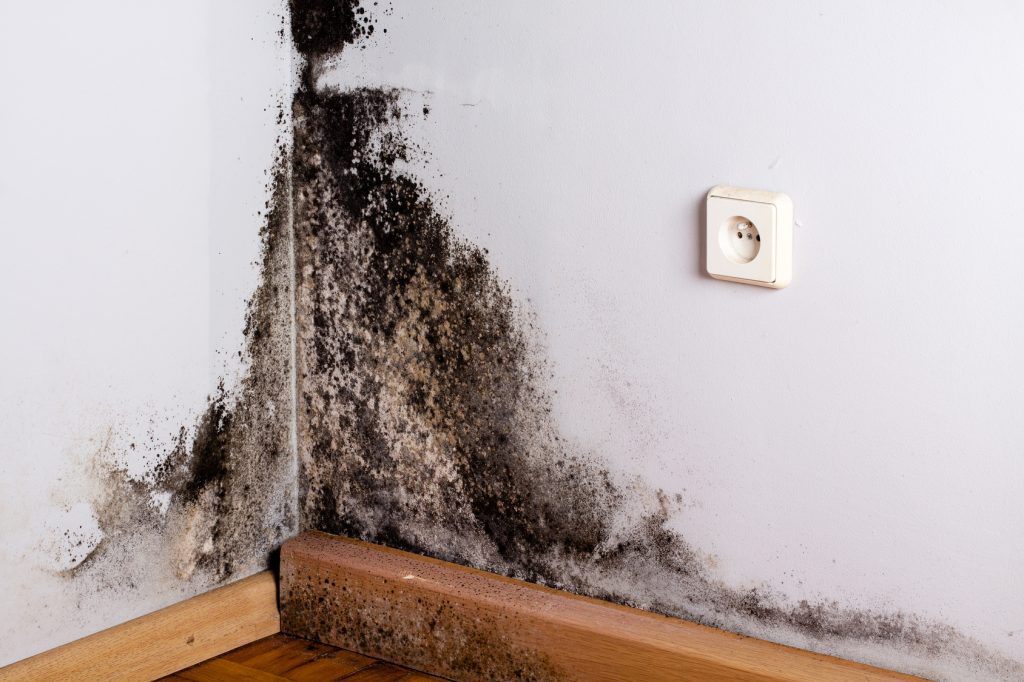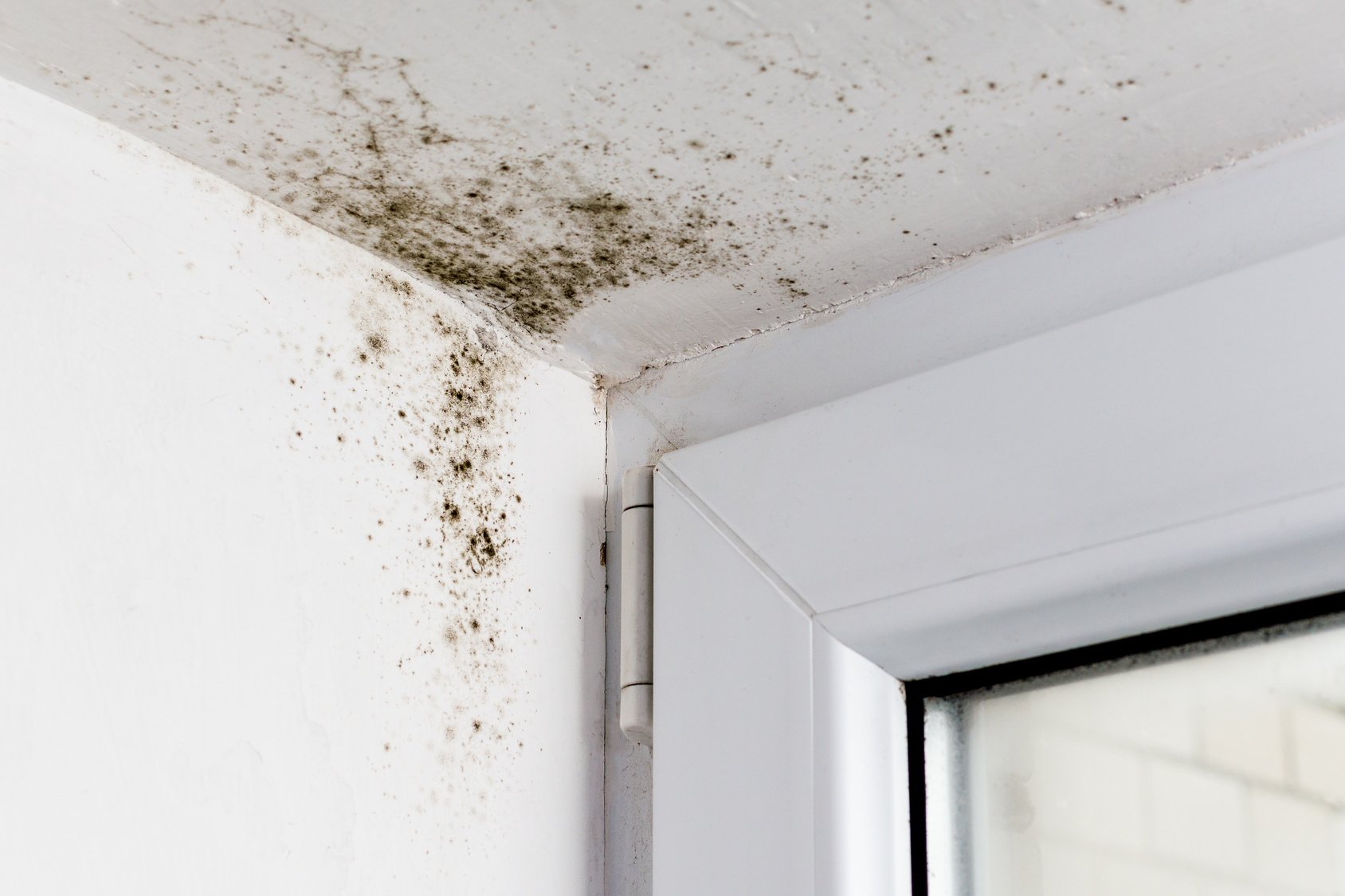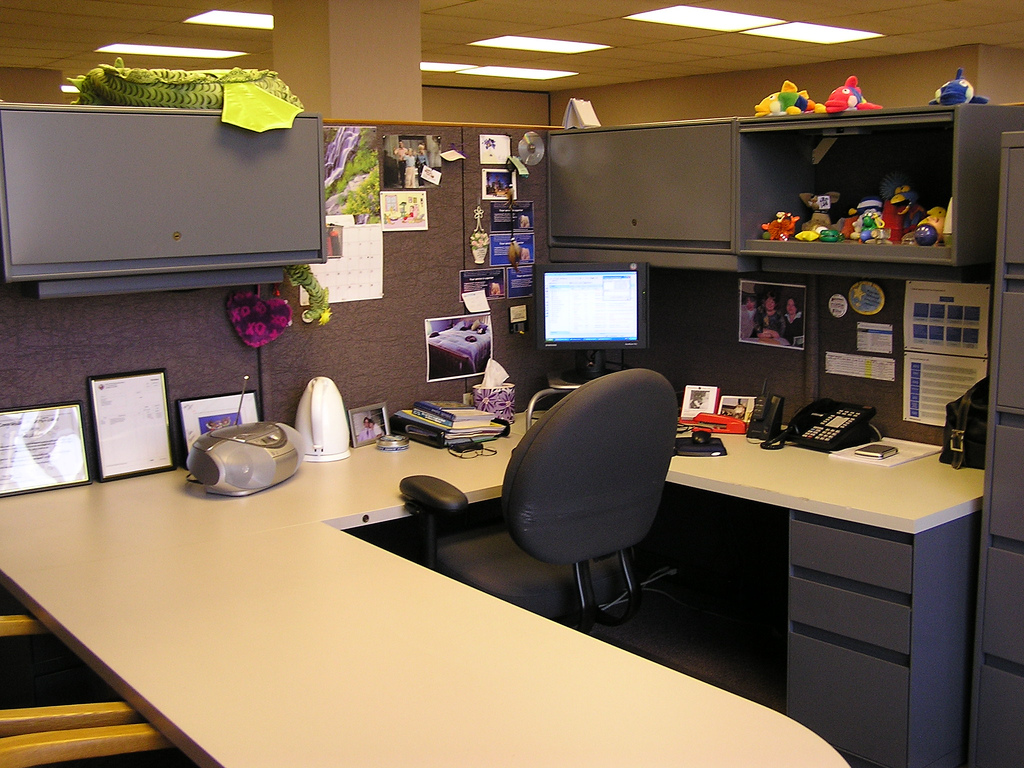What Does Mold Need to Survive?

MoldMold is a type of fungus that grows in damp or humid conditi... More is an environmental nuisance when its sporesSpores are microscopic reproductive units of fungi or mold t... More meander through the natural habitat and land in your home. All it takes is a single, microscopic spore to land on an organic substance and rapidly flourish under the right conditions. Once the moldMold is a type of fungus that grows in damp or humid conditi... More sporesSpores are microscopic reproductive units of fungi or mold t... More feed on the proper nutrients, they swell and form what is known as a hyphae. These hyphae swiftly spread, making visible the recognizable black moldMold is a type of fungus that grows in damp or humid conditi... More splotches.
When found indoors, moldMold is a type of fungus that grows in damp or humid conditi... More can discolor property, destroy and weaken building structures, cause illness and spread a musty, pungent odorAn odor is a smell, often detectable by the human nose, whic... More throughout the home or building. As a result, moldMold is a type of fungus that grows in damp or humid conditi... More is a dangerous organism when growing within spaces inhabited by humans. Homeowners and business owners alike will want to rid their home or building space of moldMold is a type of fungus that grows in damp or humid conditi... More the instant it is noticed.
MoldMold is a type of fungus that grows in damp or humid conditi... More is actually a type of fungus, but fungus is not moldMold is a type of fungus that grows in damp or humid conditi... More. The terms cannot be interchanged. While moldMold is a type of fungus that grows in damp or humid conditi... More and fungus are related, moldMold is a type of fungus that grows in damp or humid conditi... More is really a subset of fungus. Both moldMold is a type of fungus that grows in damp or humid conditi... More and fungus have their own distinguishable characteristics and functions.
Scientists have identified over 100,000 moldMold is a type of fungus that grows in damp or humid conditi... More species, out of which 80 are harmful to humans. Surprisingly, moldMold is a type of fungus that grows in damp or humid conditi... More falls into its own category of living organisms, since it is neither an animal, plant nor bacteria. Of all the moldMold is a type of fungus that grows in damp or humid conditi... More species, each can be roughly categorized into one of three types: allergenic, pathogenic and toxigenic. Allergenic molds may provoke allergies but don’t necessarily cause illness; pathogenic molds cause infections in people who suffer from immune system deficiencies; and toxigenic molds are toxic to anyone who comes in contact with the sporesSpores are microscopic reproductive units of fungi or mold t... More.
Despite moldMold is a type of fungus that grows in damp or humid conditi... More wreaking havoc within homes and buildings and causing illness in some people, moldMold is a type of fungus that grows in damp or humid conditi... More offers numerous benefits to humans and our natural ecosystem. MoldMold is a type of fungus that grows in damp or humid conditi... More is responsible for breaking down biodegradable goods, for instance. Molds are even cultivated to make medicine, like penicillin.
What conditions contribute to the growth of moldMold is a type of fungus that grows in damp or humid conditi... More indoors? Plenty of nutrients are found within homes and buildings to allow moldMold is a type of fungus that grows in damp or humid conditi... More to flourish:
Organic Surfaces
Any organic surface, including all biodegradable items, like paper and leather, can serve as a food source for moldMold is a type of fungus that grows in damp or humid conditi... More sporesSpores are microscopic reproductive units of fungi or mold t... More. MoldMold is a type of fungus that grows in damp or humid conditi... More finds nutrients in food particles, waste from cockroaches and dust mites, and even skin flakes. MoldMold is a type of fungus that grows in damp or humid conditi... More can be found behind wallpaper, underneath damp carpeting or even growing on leather couches. In fact, moldMold is a type of fungus that grows in damp or humid conditi... More finds a habitable place to thrive in areas like
- Wallboards
- Rags
- Cloth
- Ceiling tiles
- Books
- Drapes
- Upholstery
- Clothing
- Paint
- Household dust
While moldMold is a type of fungus that grows in damp or humid conditi... More cannot grown on inorganic materialsInorganic materials are substances that are not derived from... More, like glass, concrete or metal, moldMold is a type of fungus that grows in damp or humid conditi... More sporesSpores are microscopic reproductive units of fungi or mold t... More will thrive on the dust found on these surfaces.

Black moldMold is a type of fungus that grows in damp or humid conditi... More can grow on many household surfaces.
Moisture
In combination with an organic food source, sporesSpores are microscopic reproductive units of fungi or mold t... More also need moisture to survive. MoldMold is a type of fungus that grows in damp or humid conditi... More sporesSpores are microscopic reproductive units of fungi or mold t... More absorb moisture in the air and expand, extending to other parts of the property that supply sufficient dampness.
A dark, wet basement is an ideal spot for moldMold is a type of fungus that grows in damp or humid conditi... More sporesSpores are microscopic reproductive units of fungi or mold t... More to find plenty of nutrients. A leaky water pipe provides a continual water source for moldMold is a type of fungus that grows in damp or humid conditi... More to feed on. When a roof leaks, the surrounding walls become dampened; in turn, moldMold is a type of fungus that grows in damp or humid conditi... More discovers an excellent source of nutrients situated along the saturated wall. Even areas around over-watered houseplants serve as an optimum spot for moldMold is a type of fungus that grows in damp or humid conditi... More to grow.
Along with a sustainable water source, a humid environment is conducive to moldMold is a type of fungus that grows in damp or humid conditi... More growth. Indoor humidityHumidity is the amount of moisture or water vapor present in... More that ranges from 40 to 100 degrees Fahrenheit is perfect for moldMold is a type of fungus that grows in damp or humid conditi... More to thrive, especially when combined with a sound organic food source.
Poor ventilationVentilation is the process of exchanging or circulating air ... More also encourages moldMold is a type of fungus that grows in damp or humid conditi... More growth. Inadequate ventilationVentilation is the process of exchanging or circulating air ... More results in higher humidityHumidity is the amount of moisture or water vapor present in... More levels within the home or building, which in turn ensures condensation buildup. This accumulation of tiny water droplets inside gives moldMold is a type of fungus that grows in damp or humid conditi... More an ideal spot to feed.
Moisture-logged areas like bathrooms without running fans are frequented by moldMold is a type of fungus that grows in damp or humid conditi... More sporesSpores are microscopic reproductive units of fungi or mold t... More. Homeowners often find moldMold is a type of fungus that grows in damp or humid conditi... More growing behind the toilet, along the ceiling or on bathroom tiles. The common occurrence of moldMold is a type of fungus that grows in damp or humid conditi... More in the bathroom is due to the presence of adequate and constant moisture.
How Much Moisture Does Mold Need to Grow?
MoldMold is a type of fungus that grows in damp or humid conditi... More requires a certain level of moisture to grow and thrive. The specific level of moisture needed can vary depending on the type of moldMold is a type of fungus that grows in damp or humid conditi... More present, but generally, moldMold is a type of fungus that grows in damp or humid conditi... More sporesSpores are microscopic reproductive units of fungi or mold t... More require a relative humidityRelative humidity (RH) is the percentage of moisture in the ... More of around 70% or higher to start growing.
It’s important to note that even small amounts of moisture can be enough for moldMold is a type of fungus that grows in damp or humid conditi... More to grow. Even a tiny water leak or high humidityHumidity is the amount of moisture or water vapor present in... More levels can create the ideal conditions for moldMold is a type of fungus that grows in damp or humid conditi... More infestation, especially in areas where adequate ventilationVentilation is the process of exchanging or circulating air ... More is lacking.
What is the Ideal Indoor Humidity Level?
To prevent moldMold is a type of fungus that grows in damp or humid conditi... More growth and maintain a healthy indoor environment, it is crucial to maintain the right humidityHumidity is the amount of moisture or water vapor present in... More level. The best humidityHumidity is the amount of moisture or water vapor present in... More level to maintain indoors is generally between 30% and 50%. This range is considered optimal for both human health and moldMold is a type of fungus that grows in damp or humid conditi... More preventionPrevention refers to actions taken to reduce the likelihood ... More.
Keeping humidityHumidity is the amount of moisture or water vapor present in... More levels low helps to inhibit moldMold is a type of fungus that grows in damp or humid conditi... More growth. When humidityHumidity is the amount of moisture or water vapor present in... More levels are below 30%, it becomes difficult for moldMold is a type of fungus that grows in damp or humid conditi... More sporesSpores are microscopic reproductive units of fungi or mold t... More to absorb enough moisture to thrive. Additionally, low humidityHumidity is the amount of moisture or water vapor present in... More levels can help prevent condensation from forming on surfaces, reducing the chances of moldMold is a type of fungus that grows in damp or humid conditi... More finding a suitable environment to grow.
On the other hand, extremely low humidityHumidity is the amount of moisture or water vapor present in... More levels can leadLead is a heavy metal that can be toxic to humans, especiall... More to dry and uncomfortable conditions for occupants. Dry air can cause respiratory discomfort, dry skin, and other health issues. It is important to strike a balance to avoid both excessive moisture and overly dry conditions.
To monitor humidityHumidity is the amount of moisture or water vapor present in... More levels, you can use a hygrometer, a device that measures the moisture contentMoisture content is the amount of water present in a materia... More in the air. This will allow you to maintain humidityHumidity is the amount of moisture or water vapor present in... More at an appropriate level by using dehumidifiers or humidifiers if necessary.
In areas where moisture is prone to accumulation, such as bathrooms, kitchens, and basements, it is recommended to use exhaust fans or ventilationVentilation is the process of exchanging or circulating air ... More systems to remove excess moisture and maintain proper airflow.
Warmth
MoldMold is a type of fungus that grows in damp or humid conditi... More sporesSpores are microscopic reproductive units of fungi or mold t... More cannot grow in subfreezing temperatures. That’s why you’ll almost never see moldMold is a type of fungus that grows in damp or humid conditi... More growing inside a functional freezer. Cold areas do not guarantee that moldMold is a type of fungus that grows in damp or humid conditi... More will not grow. But warm climates inside a home, along with moisture and a food source, can provide the right sustenance for moldMold is a type of fungus that grows in damp or humid conditi... More growth.
MoldMold is a type of fungus that grows in damp or humid conditi... More thrives in warmer environments, typically between 77°F (25°C) and 86°F (30°C). These temperatures provide the ideal conditions for moldMold is a type of fungus that grows in damp or humid conditi... More sporesSpores are microscopic reproductive units of fungi or mold t... More to germinate and multiply.
Additionally, warmth accelerates the growth cycle of moldMold is a type of fungus that grows in damp or humid conditi... More. MoldMold is a type of fungus that grows in damp or humid conditi... More can start developing within 24 to 48 hours in optimal conditions, and warmer temperatures can speed up this process. This is why it’s crucial to address any moisture issues promptly and maintain a healthy indoor temperature to prevent moldMold is a type of fungus that grows in damp or humid conditi... More from proliferating.

Condensation near a window can cause moldMold is a type of fungus that grows in damp or humid conditi... More.
SEE ALSO: Important Reasons to Have a Professional Remove Mold from Your Home
Oxygen
As a living organism, moldMold is a type of fungus that grows in damp or humid conditi... More needs oxygenOxygen is a chemical element essential for combustion and li... More to survive. Where there is a lack of oxygenOxygen is a chemical element essential for combustion and li... More, moldMold is a type of fungus that grows in damp or humid conditi... More cannot live.
When an organic food source is combined with moisture and oxygenOxygen is a chemical element essential for combustion and li... More, then moldMold is a type of fungus that grows in damp or humid conditi... More sporesSpores are microscopic reproductive units of fungi or mold t... More feast. Plus, it doesn’t take long for moldMold is a type of fungus that grows in damp or humid conditi... More to begin its destructive path when the circumstance is right. In fact, just 48 hours are all that is needed for moldMold is a type of fungus that grows in damp or humid conditi... More to take hold.
MoldMold is a type of fungus that grows in damp or humid conditi... More is a natural byproduct of the environment and can be found everywhere in nature. Home and business owners cannot escape moldMold is a type of fungus that grows in damp or humid conditi... More, but it is possible to limit the growth of moldMold is a type of fungus that grows in damp or humid conditi... More inside. Reduce the inside moisture contentMoisture content is the amount of water present in a materia... More to between 30 and 60 percent, and stop the rapid advance of moldMold is a type of fungus that grows in damp or humid conditi... More quickly.
As soon as you detect moldMold is a type of fungus that grows in damp or humid conditi... More inside your home or business property, take steps to remove it. First, find the water source that feeds the moldMold is a type of fungus that grows in damp or humid conditi... More. SporesSpores are microscopic reproductive units of fungi or mold t... More cannot die off unless the moisture in the area is removed. Even if you kill the moldMold is a type of fungus that grows in damp or humid conditi... More sporesSpores are microscopic reproductive units of fungi or mold t... More, they will return if water is available. So fix the plumbing leak or water damage as soon as possible.
Professional Mold Removal
When the moldMold is a type of fungus that grows in damp or humid conditi... More infestation is large, it is critical to contact a mold remediation service to eliminate the moldMold is a type of fungus that grows in damp or humid conditi... More from your property. RestorationMaster offers comprehensive mold remediationMold remediation is the process of identifying, removing, an... More services to thoroughly remove all moldMold is a type of fungus that grows in damp or humid conditi... More from your building and even prevent it from returning.
RestorationMaster’ trained technicians first visually inspect the moldMold is a type of fungus that grows in damp or humid conditi... More growth, then work with an independent third party to locate hidden moldMold is a type of fungus that grows in damp or humid conditi... More growth as well as test the air quality. Once the independent assessment is complete, the RestorationMaster team develops and implements a mold remediationMold remediation is the process of identifying, removing, an... More plan. The professionals at RestorationMaster utilize advanced equipment and specialized products to eliminate all traces of moldMold is a type of fungus that grows in damp or humid conditi... More. As soon as the moldMold is a type of fungus that grows in damp or humid conditi... More is removed, the specialists perform another air quality test to ensure the property is safe to inhabit.












